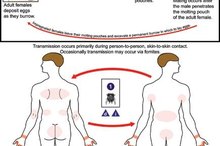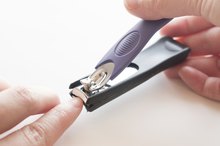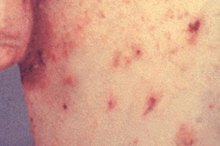What does fact checked mean?
At Healthfully, we strive to deliver objective content that is accurate and up-to-date. Our team periodically reviews articles in order to ensure content quality. The sources cited below consist of evidence from peer-reviewed journals, prominent medical organizations, academic associations, and government data.
The information contained on this site is for informational purposes only, and should not be used as a substitute for the advice of a professional health care provider. Please check with the appropriate physician regarding health questions and concerns. Although we strive to deliver accurate and up-to-date information, no guarantee to that effect is made.
Mattress Care for Scabies
Scabies (Sarcoptes scabiei var. hominis) are small, eight-legged, mites that burrow under human skin. Scabies infection causes intense itching and a tell-tale rash of bumpy, red lines. Scabies are highly contagious. People can transmit scabies through casual contact, and by sharing personal items such as bed linens and mattresses. Mattress infestation can be difficult to quell, as they cannot be machine-washed and dried to kill the bugs. There are several measures you can take to kill scabies on a mattress to prevent re-infestation.
Extermination
Spray both sides of the mattress with permethrin spray. Permethrin is a pesticide commonly used to kill head-lice and also kills scabies. Permethrin spray can be purchased over the counter at most drug stores. Do not allow anyone to touch the mattress until the spray has dried thoroughly. Permethrin is a neurotoxin that can be dangerous to humans, and should be used cautiously. This is also the active ingredient in Food and Drug Administration-approved topical scabies medications.
- Spray both sides of the mattress with permethrin spray.
- Permethrin is a pesticide commonly used to kill head-lice and also kills scabies.
Prevention
Mange Treatment for Humans
Learn More
Vacuum both sides of the mattress thoroughly. Scabies can live on the mattress for up to 72 hours without a human host. For this reason, the bed should be vacuumed every three days until the skin infestation is gone. This will help remove mite eggs and prevent them from hatching in the mattress. It is essential to wash and dry all bedding on the hottest possible setting so that no new scabies infest the mattress.
Use a plastic under-sheet and change linens daily. It may take several applications of the lotion or cream prescribed by the doctor to kill scabies. These permethrin-based lotions do not penetrate scabies eggs, which may fall on the mattress and hatch. A plastic sheet prevents the mites and their eggs from ever touching the mattress. Fresh linens protect against reinfestation. Place pillows in the dryer on the hottest setting possible for an hour each day until you get the all-clear from your doctor.
- Vacuum both sides of the mattress thoroughly.
- Place pillows in the dryer on the hottest setting possible for an hour each day until you get the all-clear from your doctor.
Repeat
Repeat the entire process every two weeks until the doctor confirms that the skin infestation is gone. Scabies is easily spread and hard to kill 3. This makes reinfestation quite common. Also, scabies infection may not produce any symptoms for as long as six weeks after infection. Scabies is contagious with or without symptoms, so mattress care cannot be neglected. It is impossible to tell if you have vacuumed all of the eggs out of the mattress. These eggs may hatch and infest anyone who uses the mattress.
- Repeat the entire process every two weeks until the doctor confirms that the skin infestation is gone.
- Also, scabies infection may not produce any symptoms for as long as six weeks after infection.
Related Articles
References
- Safe2Use; Permethrin information
- Mayo Clinic; Scabies
- Centers for Disease Control and Prevention; Scabies
- Micali G, Lacarrubba F, Verzì AE, Chosidow O, Schwartz RA. Scabies: Advances in Noninvasive Diagnosis. PLoS Negl Trop Dis. 2016;10(6):e0004691. doi:10.1371/journal.pntd.0004691
- Chandler DJ, Fuller LC. A Review of Scabies: An Infestation More than Skin Deep. Dermatology (Basel). 2019;235(2):79-90. doi:10.1159/000495290
- Su WJ, Fang S, Chen AJ, Shan K. A case of crusted scabies combined with bullous scabies. Exp Ther Med. 2015;10(4):1533-1535. doi:10.3892/etm.2015.2668
- Crusted scabies. Genetic and Rare Diseases Information Center. Published June 17, 2019.
- Mccarthy JS, Kemp DJ, Walton SF, Currie BJ. Scabies: more than just an irritation. Postgrad Med J. 2004;80(945):382-7. doi:10.1136/pgmj.2003.014563
- Centers for Disease Control and Prevention (CDC). "Scabies—Resource for Health Professionals." Atlanta, Georgia; updated March 21, 2017.
- Stiff KM, Cohen PR. Scabies Surrepticius: Scabies Masquerading as Pityriasis Rosea. Cureus. 2017 Dec 19;9(12):e1961. doi: 10.7759/cureus.1961.
Writer Bio
Heather Monroe has been writing for Demand Studios since March, 2009. Heather enjoys blogging about California's beautiful Inland Empire and its rich history. She has also published her own line of greeting cards and tee-shirts. Although she got a bit of a late start, Heather is pursuing a degree in Journalism.






